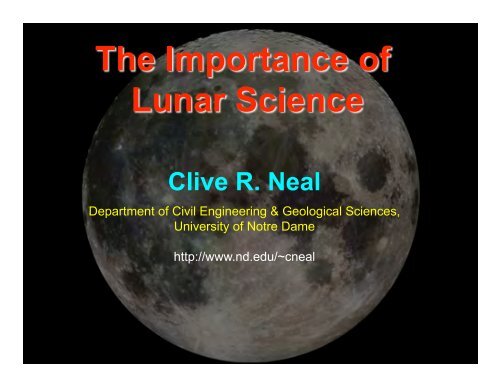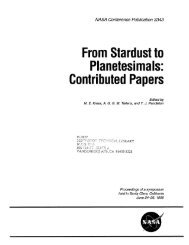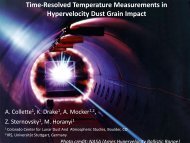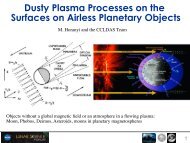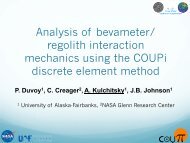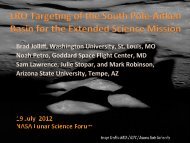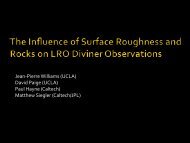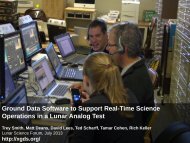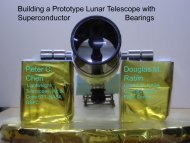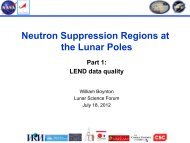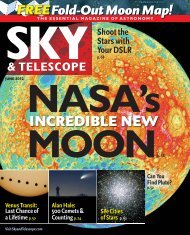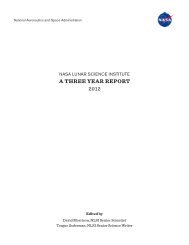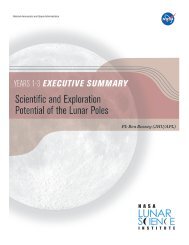here - NASA Lunar Science Institute
here - NASA Lunar Science Institute
here - NASA Lunar Science Institute
Create successful ePaper yourself
Turn your PDF publications into a flip-book with our unique Google optimized e-Paper software.
Clive R. NealDepartment of Civil Engineering & Geological <strong>Science</strong>s,University of Notre Damehttp://www.nd.edu/~cneal
Apollo 11on theNational MallLROC NAC
Apollo Landing Sites (1969-1972)151712141611
Apollo Exploration of the USA
Magma Ocean concept applied to Earth (e.g., McCulloch et al.,1986) and Mars (Elkins-Tanton et al., 2003).
SamplesHighlands (intrusive)Mare (extrusive)BasaltsFerroan Anorthosites(FANs)GlassesCrystallineBasaltsMg-SuiteAlkali SuiteVery Low-Ti (VLT)Low-TiHigh-Ti“KREEP”
Unhappy Moon!
Helium-3Nuclear fusion of 3 He produces noradioactive waste and (theoretically)a lot of energy!As a replacement for that fuel,that 25-tonne load of 3 He wouldworth on the order of $75 billiontoday, or $3 billion per tonne.
[B. Jolliff et al. (2000)JGR 105, 4197]Terrane Boundaries.
Exogenous Volatiles on the Moon
Exogenous/Endogenous Volatiles on the Moon?
Old Paradigm, new planet:“We’ve found water on Mars the Moon – again!!”
Apollo 17
Endogenous VolatilesSaal et al. (2008Nature 454, 192-195)H 2 OClApollo 15 Green Glass (VLT)Water in the Glass Parent Magma:260-745 ppmFS
Endogenous VolatilesOH content of phosphates14053 McCubbin et al. (2010)Proc. Nat. Acad. Sci. 107,11223-11228.Water in Mare BasaltSources: 2-5 ppm14053,241Liu et al. (2010) LPSC 41Boyce et al. (2010) Nature 466, 466-469
Network too restricted to defineglobal lunar structure
Four types of events induceseismicity on the Moon.
Dainty et al. (1974)The Moon 9, 11-29.
The Moon is the smallest planetary body in the innersolar system with an old planetary surface.It’s evolution was halted at an early stage so itsstructure represents the initial stages of terrestrialplanet differentiation.The Moon t<strong>here</strong>fore represents an end-member.
Jolliff et al. (2000) JGR 105, 4197Giguere et al. (2000) MaPS 35, 193
New Views of the Moon (2006) B.L. Jolliff, M.A.Wieczorek, C.K. Shearer, and C.R. Neal, editors,720 p. Reviews in Mineralogy and Geochemistry,Volume 60. Mineralogical Society of America.ISBN 1529-6466.Neal C.R. (2009) The Moon 35 years after Apollo:What’s left to be done?Chemie der Erde – Geochemistry, 69, 3-43 [doi:10.1016/j.chemer.2008.07.002].
Oberst & Nakamura (1992) 2nd Conference on <strong>Lunar</strong> Bases & Space Ac>vi>es
Plas>c/liquidzones?
Commercial Services forRefueling depots.
• The current robotic missions(LRO and LCROSS) are notsufficient.
Soviet Technology
The Moon represents the “Rosetta Stone” for the science &exploration of the Inner Solar System:• Preserves the earliest stages of planetarydifferentiation;• Preserves the early bombardment history of the innersolar system;• It is the type locality for understanding the spaceweathering of airless bodies.New missions always produce new discoveries that requirerevision of previously formulated hypotheses.Important Solar System science questions remain that canbe addressed by new missions to and data from the Moon.
The Moon is an Exploration Asset:• Technology Development (robotic & human science andexploration);• Protection technologiesfor human missions;• Systems Integration forhuman missions.


